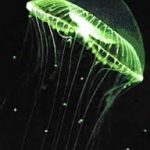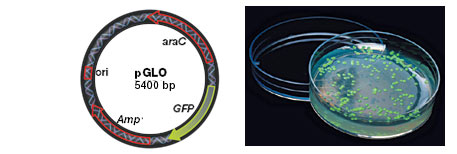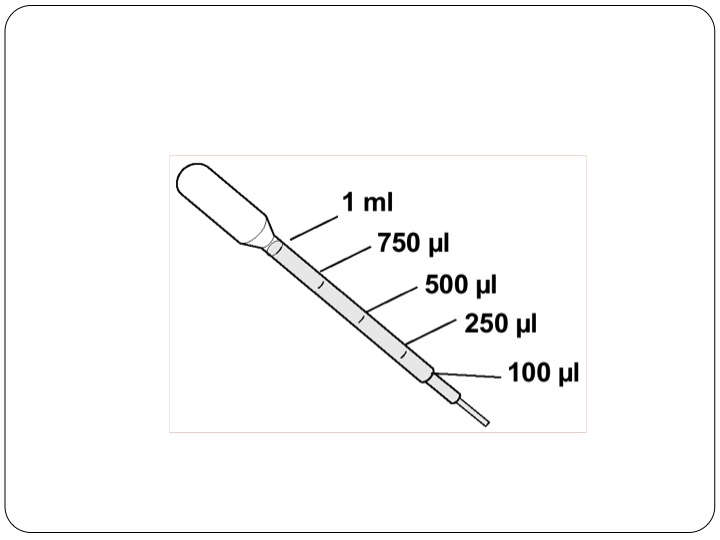Gene Transformation (2 weeks of lab)
Week 1
Background:
How GFP is used in research (10:03)
Funding Basic Science to Revolutionize Medicine (3:59) that show how the focus in research has changed over the past 50 years.
Stanford Scientists Produce Cancer Drugs from Rare Plants (1:59) by making plasmids and inserting them into more easily grown plants or yeasts.
Important Concepts in the Transformation Procedures:
Using Restriction Enzymes and DNA Ligase to make plasmids (1:38)
pGlo Plasmid we will use in lab.
DNA transformation using plasmids – animation explaining the steps in our Transformation procedure. It is very important to understand the nature of the bacterial cell wall, why CaCl2 is used, and why the heat shock is important.
Video of BIORAD pGlo Transformation procedure (p. 23-28 in your lab manual)
Measurement marks on disposable plastic pipettes provided in the BIORAD kit:
Week 1 – Hypotheses for Results of each of the agar plates inoculated:
- Fill out the table on page 29 to indicate what you think the results would be for each of the 4 agar plates that were inoculated in this procedure. Also fill out the gray boxes for the agar plates that were not inoculated. Include why you think you’d get these results in ALL the boxes as well.
Week 2
Actual Results: The following pictures show the bacterial growth on the different nutrient agar plates under white light and UV light from a previous semester.
- Record the data in Table 1 page 33 that corresponds to the Group/Table where you normally sit in the lab room. Be sure to collect the data from both the White Light and the UV Light pictures. For example, if you sit at Table 3 in the room, you only need to record data from the Group 3 pictures – both white light (3-WL) and UV light (3-UV).
- Answer the questions on pages 33-34.
| Light Source | Group 1 | Group 2 | Group 3 | Group 4 | Group 5 | Group 6 |
| White Light (WL) | 1-WL | 2-WL | 3-WL | 4-WL | 5-WL | 6-WL |
| UV Light (UV) | 1-UV | 2-UV | 3-UV | 4-UV | 5-UV | 6-UV |
Calculate the Transformation efficiency using the data from the +LB/amp/ara agar plate.
- Follow the directions one pages 35-37 to calculate your transformation efficiency. Be sure to include the units as you set up each equation. You will not be able to fill in the Class Results (Table 2).
- Answer the questions on page 39. You will not be able to answer question 2, but do answer #3 in relation to the ideal transformation efficiency (#1) found on page 35.
Molecular Visualization of DNA
0-1:48 = DNA Structure — Also seen in the Mitosis and Meiosis lab
1:48-2:53 = DNA Replication –Can you relate this to DNA synthesis? = S phase that you leaned about in the Mitosis and Meiosis in lecture
2:53-4:48 = Transcription – (you will learn about this and Translation later in lecture)
4:48-6:57 = Translation – (you will learn about this and Translation later in lecture)
6:58-7:47 = Hemoglobin and Sickle Cell Anemia -not narrated
[callout heading=”DNA Presentations will be compiled by Table Groups in PowerPoint and recorded with both audio and video via Zoom. Share the Zoom video with your TA due by Apr. 13-17.” headingicon=”noicon” textalign=”textcenter” type=”basic” bgcolor=”huntyellow”]To practice your presentations skills, each group of students will receive a DNA Topic and Target Audience to present to the class. These presentations should run 5-10 minutes. Each individual will need to turn in a self assessment of their own presentation skills. See the links below for more information. This will help you better organize and present your Final Bacterial Project to the class.[/callout]
DNA Presentation Expectations and Self Assessment – 30 points
DNA Presentation Evaluation Sheet
Link to information on a Minor in the Biotechnology Program at NCSU and Courses in Biotechnology (BIT) at NCSU
Link to the BTEC center on Centennial Campus NCSU – where industry and education meet.
Check out the opportunities for undergraduate students! Certificate, Minor, Courses…..(look under Academic Programs)
At BTEC they use similar transformation procedures to engineer bacteria and yeasts to make (biomanufacturing) chemicals, medicines, vaccines, enzymes, proteins, biofuels…….
Great Short articles related to this important technology !
Color-Changing Flowers – Biotechnology for Everyone – A good short discussion GMOs, mechanics on what was done to change color in Petunias – the first genetically modified flower commercially available.
Could Panda Poop Be the Secret to More Efficient Biofuels? – Short article about using genes from bacteria found in Panda feces and inserting them into yeast to increase biofuel efficiency.



